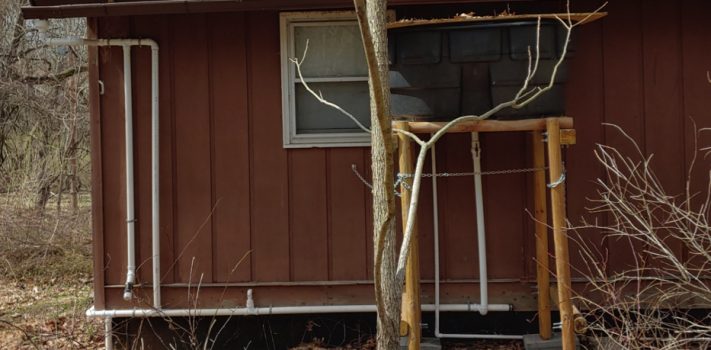Email a copy of 'A Gravity-Fed Rainwater System, by Tractorguy' to a friend
14 Comments
- Ad USA Berkey Water Filters - Start Drinking Purified Water Today!#1 Trusted Gravity Water Purification System! Start Drinking Purified Water now with a Berkey water filtration system. Find systems, replacement filters, parts and more here.
- Ad Ready Made Resources Anytone Termn-8RCall us if you have Questions 800-627-3809


I’m curious what you do for water during winter months? Or is your system only used as a supplement for another water source? Thanks.
Very much appreciate this hands on, informative article.
I have an off grid cabin in what is more or less desert country…wells are very expensive (30,000 and up)…we have 8000 gallons rainwater storage…a very simple RV pump (12volt) pumps our water through various filters…we chlorinate in the tanks to eliminate bacteriological hazards and remove the chlorine with various carbon filters…works very well….everyone who does not have surface water or fairly inexpensive access to well water should seriously consider rain water.
1st check if there is adaquate rain
ThoDan, even very dry climates which receive only 12 inches of rain a year can produce substantial amounts of water. Consider 12 inches of rain annually on an 1800 square foot roof would yield 1800 cubic feet of water. That is over 13,000 gallons of water.
When making weight calculations note that fresh water actually weighs 8.33 lb/gal.
I am curious as to why you need to completely drain the tank for winter. Ye olde internet tells me water increases 9-10% in volume when frozen. 1 gal = 3.8 liters. So 1 gal. water frozen = 3.8 + (rounding up to be safe) 0.4 = 4.2 gals. frozen.
Is there a reason for not draining it just partially? Climate? Here in Mississippi our 250gal. tank (which we take down about 15% in the fall if it’s full) has had a couple of inches of ice on top a few times, but it just don’t stay cold that long. Am I missing something?
The output elbow and valve would probably suffer freeze damage. It would also take a very long time at springtime temperatures around here for a 150 gallon block of ice to thaw! When I un-winterize the system in the spring it typically fills enough in less than a week to resume flushing the toilet.
WRANGLERSTAR has an excellent series on building a gravity-fed water tower that addresses weights, pressures, the general homestead level engineering etc. He also talks about using a ram pump to trickle-feed the tank and keep it topped off.
The files are both labeled part two for some reason, but here are the links:
https://www.youtube.com/watch?v=-z0OJL0HblU
https://www.youtube.com/watch?v=B7jyPSTajxQ
Here in the redout, at 4000 feet elevation, burying the tank in the hillside can fix the problem of the tank freezing. However, it does nothing to protect the gutters against glacial activity! An 8- or 10-inch-thick sheet of ice sliding off the 12/12-pitch roof is pretty destructive! Does anyone have experience with quick-detach/retractable gutter systems?
At our former redoubt home at 5,000 feet, our gutters would fill with melt then freeze solid, then melt would run over the gutters and freeze in huge icicles and sheets which placed enormous strain on the gutters and result in icefalls freezing to the house.
Many gutters are just attached to the house by driving big spikes into the house, usually with a metal sleeve around them inside the gutter, and those spikes almost immediately loosen up and poorly constructed gutters then pull away from the house when loaded with heavy weight.
Two solutions are beneficial. First, install modern gutter brackets which screw into the wood. Second, we installed electric de-icing cables inside our gutters,and their down spouts, and plugged them in for a few hours when needed to re-etablish gutter flowing capability. You could also install ‘heat tape’ to thaw ice.
https://www.amazon.com/Heat-Tape-Plug-Self-Regulating-Cable/dp/B01N5D89UP/ref=sr_1_1_sspa?crid=SEPFG136AURJ&keywords=gutter+deicing+cable&qid=1559924357&s=gateway&sprefix=gutter+deicing%2Caps%2C208&sr=8-1-spons&psc=1
This is an excellent low cost way to utilize rainwater during the warm months. Great article. Thanks for the ideas. Stay safe Tractorguy.
At worst everyone should have at least one 50 gallon barrel either in their shed or garage up on cinderblocks with a spigot attached and kept full at all times from the outside water hose. If the power goes out this will afford enough water for a couple toilet flushes and some washing up water until you can make a better short term decision. Assuming you always keep a few 3 gallon water jugs filled with drinking water or at least a 24 pack of bottled water.
One note, last year in December when the power went off for 12 hours and the outside temp was below freezing I put all my houseplants in the smallest room and lit several candles in there and kept the door closed to keep them from freezing, then I went in periodically to check on them, and warm myself up in that room. In a worst case scenario you can also start up your car and sit in there to warm up periodically, or drive to wherever the power is on and wait there. This year definitely a wood stove.
Make sure the supports for your tank are not made of steel, unless it is stainless. A 250 gallon oil tank in the basement here rusted through, smashing the tank to the floor, and depositing all the diesel oil all over.
Thousands of dollars and a very nice DEC guy (there is such a thing) later, the problem was fixed. The good news was that the residual diesel fumes were too much for the termites that had infested the house (I rent).
Time passes. The steel supports will rust through, unless you live in the desert.